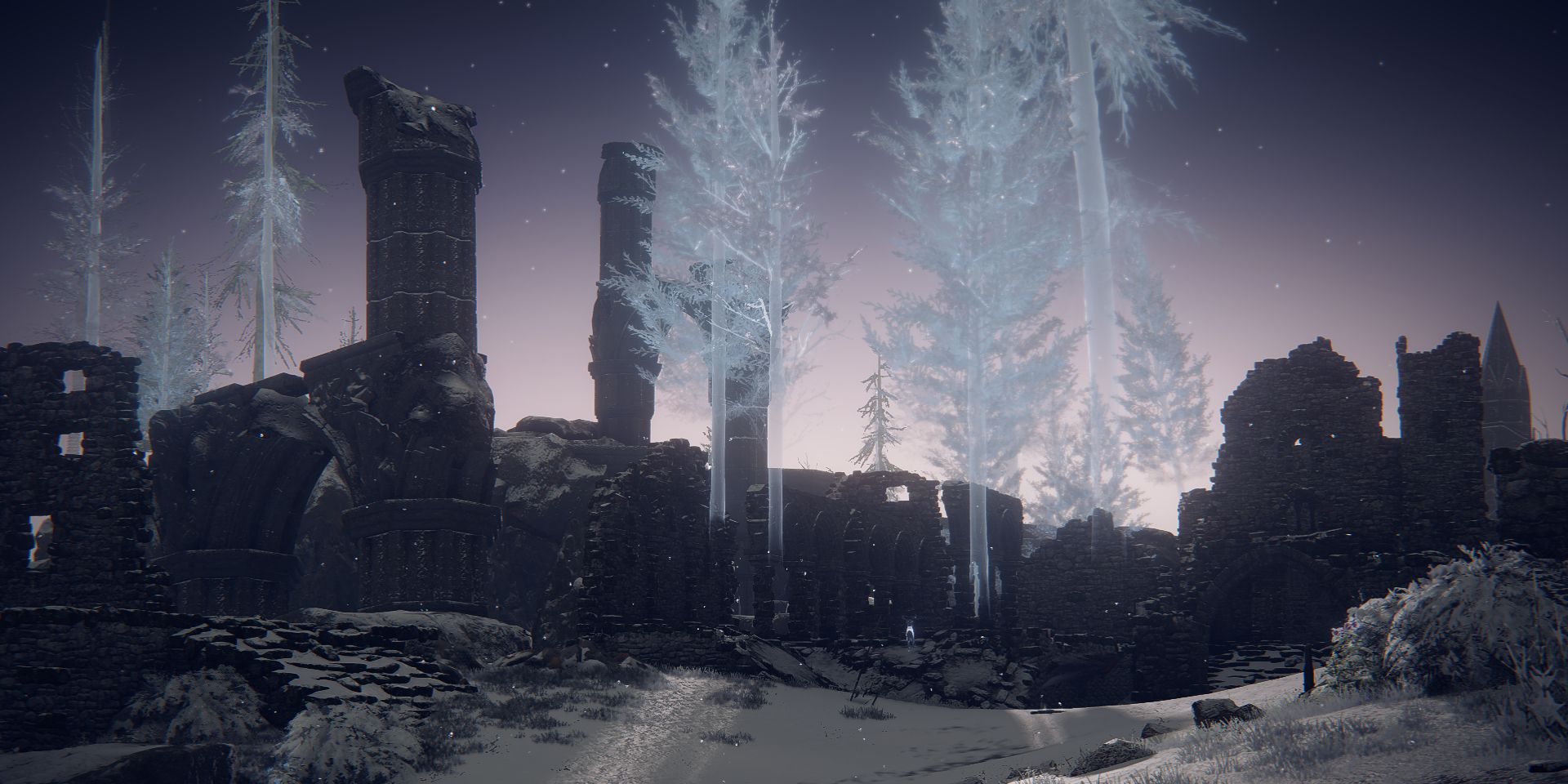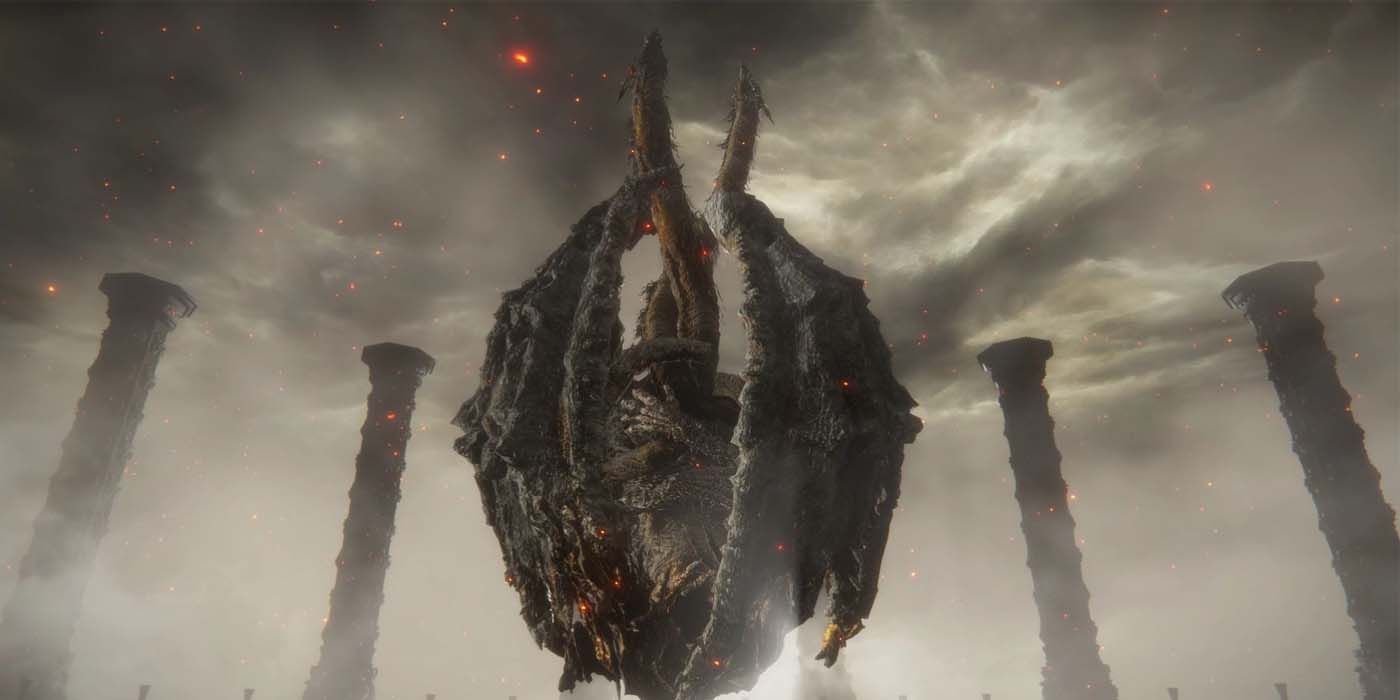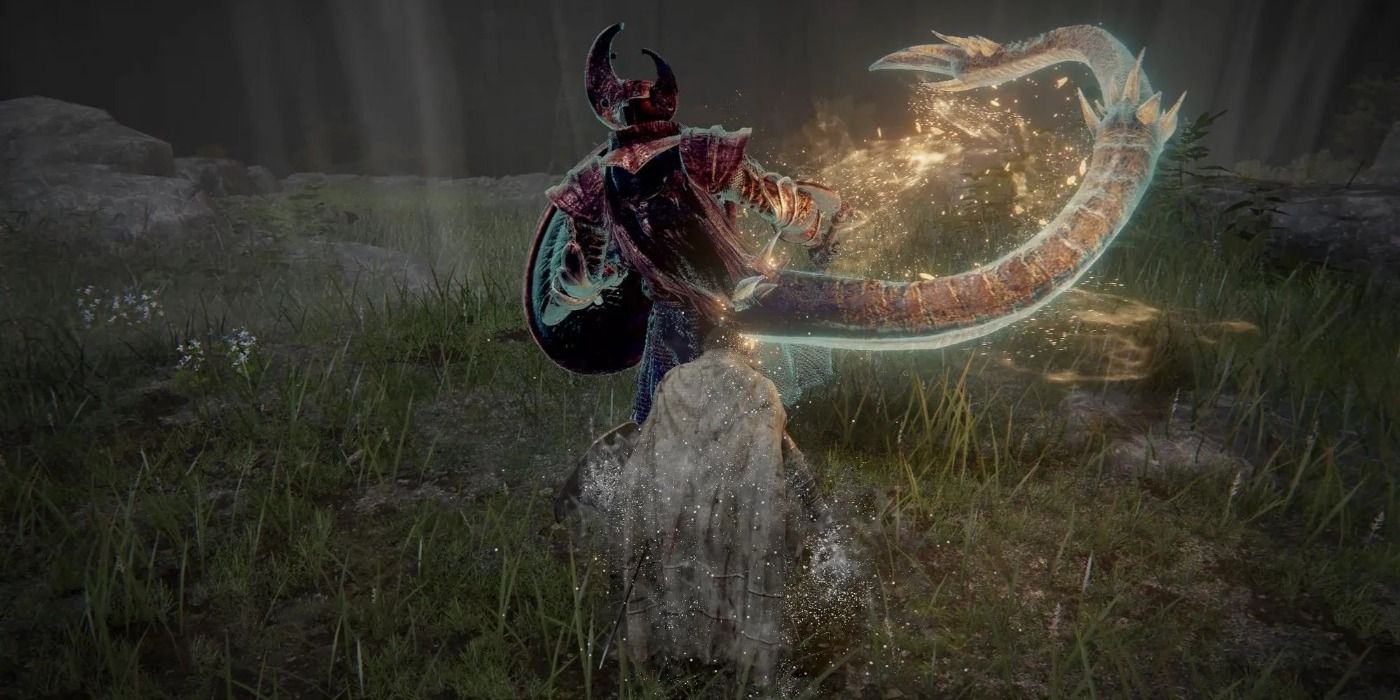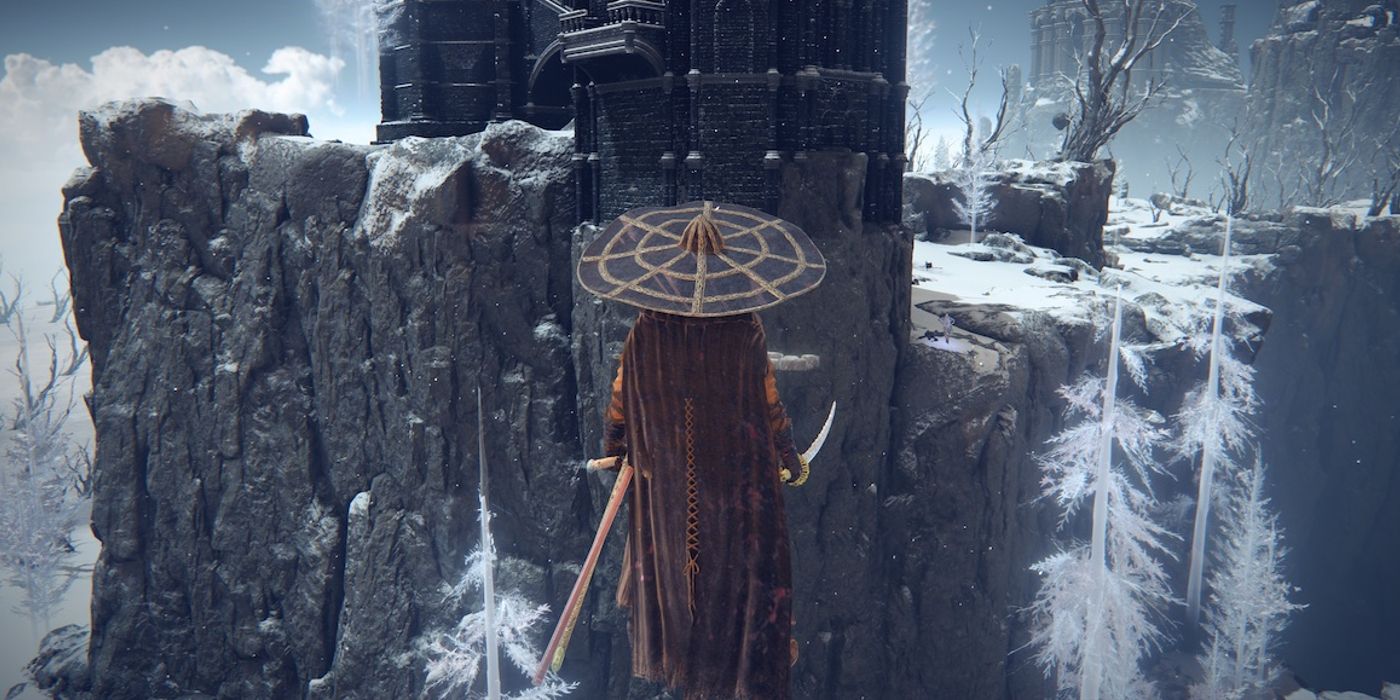FromSoftware's newest fantasy RPG Elden Ring has a very rich and intricate backstory even before its recognizable Erdtree existed, created through a collaboration between Hidetaka Miyazaki and fantasy author George R.R. Martin of Games of Thrones fame. The lion's share of Elden Ring's backstory has to do with the rise and fall of the theocratic Golden Order that once ruled over the Lands Between. Certain item descriptions, ruins, and NPC dialogue, however, hint at the existence of far older civilizations, faiths, and creeds. Some of these ancient cultures were co-opted or absorbed by Marika's Golden Order - others, destroyed by her imperial regime.
It all started with the Greater Will, a mysterious deity from outer space that sent Elden Ring's golden, Elden Star to the Lands Between, a seed-like projectile bearing an alien beast that would one day become the Elden Ring. Marika, a mysterious woman from the long-lived Numen race, became the divine vessel of the Elden Ring and founded a dynasty of demigod children with her Elden Lord consorts and the miracles of the sky-spanning Erdtree. In the process of building this Golden Order, Marika (now deified as Queen Marika the Eternal) and her devoted followers erased or assimilated many of the cultures listed below.
Elden Ring's Old Dynasty Of Ancient Dragons
By the time Elden Ring players reach the late-game area called Crumbling Farum Azula (location of Elden Ring's Ancient Dragon Prayerbook and important boss fight against Maliketh, the Black Blade), the ancient sky city is breaking apart and slowly vanishing into the timeless hurricane it orbits. At its height, however, Farum Azula was the seat and stronghold of a mighty pre-Erdtree society comprised of ancient dragons and Beastmen, the dwindling legions of which are encountered while exploring the swirling, airborne wreckage. In his prime, the ruler of this city, Dragonlord Placidusax, seems to have been as mighty and divine as Queen Marika according to the description of his Remembrance item:
The Dragonlord whose seat lies at the heart of the storm beyond time is said to have been Elden Lord in the age before the Erdtree. Once his god was fled, the lord continued to await its return.
It's unclear whether the ancient dragons of Farum Azula actively ruled the denizens and notable families of Elden Ring's Lands Between, or simply kept to their sky-borne cities of stone. Players who explore Elden Ring's open world will frequently stumble across strange, half-buried ruins, the Ruin Fragment items on them bearing descriptions of how these "shards of stone are believed to have once been part of a temple in the sky." Farum Azula is kept well hidden on the eastern edge of the world map, but these Ruin Fragments foreshadow the area's existence very early on.
Additionally, the item descriptions of Azula Beastmen weapons like the Beastman's Cleaver, the Beastman's Curved Sword, and Beastman's Jar Shield take pains to emphasize the sophisticated knowledge needed to forge these seemingly crude weapons. Even if their society wasn't an empire like the Golden Order, these Beastmen and ancient Elden Ring dragons like Fortissax were clearly civilized in their own way and may have drawn on the time powers of their patron god to freeze their floating sky temples in time, preserving them from decay and the pull of gravity.
By the Age of the Erdtree under Marika's growing power, the ancient dragons had lost contact with their god, but still possessed their fearsome draconic strength, fiery breath, and ability to hurl bolts of crimson lightning (an ironic inversion of the lightning-wielding dragon slayers from the Dark Souls games). For a brief span, they waged war against Queen Marika's Golden Order, a conflict where monumental dragon Gransax used his Elden Ring bolt weapon to breach Leyndell's walls. It was Godwyn the Golden, Marika's firstborn, who defeated the dragons, forged a peace treaty with them, and even founded a Dragon Cult dedicated to their glory.
Prehistoric Elden Ring Civilizations Revered The Primordial Crucible
Before it grew large enought to dominate every vista in the Lands Between, the Erdtree initially sprouted from divine force called the Primordial Crucible - a wellspring or nexus of golden energy that gave birth to new life and altered any existing life that was exposed to its power; in contrast to the golden magic of Erdtree Incantations and Golden Order Fundamentalist spells, the power of the Primordial Crucible and its tree (which influenced Elden Ring's Crucible Tree Armor) comes across as more wild and primal in Elden Ring lore. If the Golden Order and the Greater Will represent harmony and prosperity, then the Primordial Crucible seems to embody evolution itself, with all the implicit chaos and unpredictability that implies.
Most Elden Ring players will learn about the Primordial Crucible after encountering Crucible Knight enemies in the open world. These enemies, some of the game's most fearsome, once the personal guard of Godfrey, the First Elden Lord, wield weapons and armor forged from a red-gold alloy and covered with design motifs of horns, tree branches, animal faces, and maws. The Aspects of the Crucible Incantations they drop, which conjures forth temporary body parts such as tails, horns, or fire-spewing throat pouches, are described as manifestations of "the Erdtree's primal vital energies - an aspect of the primordial crucible, where all life was once blended together."
There's an eerie similarity between the golden appendages Crucible Knights can conjure and the mutated body parts of not-quite-human creatures such as the winged Misbegotten and horn-covered Omens like the twin Morgott and Mohg. Even though the Omen Twins were of royal heritage, the Golden Order found their mutation undesirable, and sequestered the horned beings below Leyndell. Additionally, the Crucible Knot and Crucible Feather Talismans share the following description:
A vestige of the crucible of primordial life. Born partially of devolution, it was considered a signifier of the divine in ancient times, but is now increasingly disdained as an impurity as civilization has advanced.
The implication of this game text is that divergent humanoids like Misbegotten and fell Omens such as Margit were not always scorned or despised in the Lands Between, but were once revered as holy beings blessed by the Primordial Crucible. This negative shift in religious worldview can be explained by the following theory: when Marika became a vessel of the Elden Ring and founded the Golden Order, she didn't build a civilization from scratch, but instead co-opted a pre-existing civilization - or rose to power through said civilization - that revered the Crucible and the (at the time smaller) Erdtree springing from it.
If this theory is correct (a tall order when trying to piece together FromSoftware's intentionally vague storytelling), Godfrey, First Elden Lord (aka Hoarah Loux) and his 16 faithful Crucible Knights hailed from this pre-Golden Order civilization, raised up by Queen Marika as champions in her wars against star-gazing sorcerers, Fire Giants, Dragons, and Storm Lords. As the Erdtree grew and the Golden Order grew strong and secure, the primal savagery of Godfrey and his Crucible Knights started to clash with the civilizing norms dictated by the Elden Ring. So it came to pass that Godfrey was exiled as a Tarnished, the Crucible Knights were cast aside, the Omens were persecuted, and the last vestiges of the old Crucible-worshiping ways were swept aside.
Elden Ring's Ancient Astrologers And Their Accord With The Fire Giants
The magical discipline of Elden Ring's Glintstone Sorcery, an intelligence-scaling set of spells in Elden Ring, is strongly associated with the moon, the stars and the properties of the extraterrestrial substances known as glintstone. Rare items in Elden Ring such as the Primal Glintstone Blade and the Founding Rain of Stars spell have item descriptions that talk about the very first Glintstone Sorcerers - ancient astrologers who came before the sorcerers of Raya Lucaria and Sellia.
These old Astrologers built their observatories on the high peaks of the Mountaintops of the Giants, where the Fire Giants of old made burnt offerings to the One-Eyed God and channeled the crimson Flame of Ruin. Surprisingly, these Fire Giants and astrologers seem to have gotten along fine, perhaps because their respective goals didn't conflict. The Sword of Night and Flame, a blade for Intelligence/Faith builds in Elden Ring, can launch attacks of red flame and azure comet energy and may have been fruit of giant and astrologer artifice combined based on its description:
Astrologers, who preceded the sorcerers, established themselves in mountaintops that nearly touched the sky, and considered the Fire Giants their neighbors.
By the time of the events of Elden Ring take place, the Fire Giants are long gone - all but one of them destroyed by Queen Marika, Godfrey, the fanatical legions of the Golden Order, and the fey, frost-wielding Knights of Zamor. It's unclear whether the early astrologers perished alongside the Fire Giants; they may have migrated to Liurnia in search of Glintstone, or destroyed themselves while trying to harness the power of the extremely volatile Primeval Current that empowers Elden Ring's Comet Azur and Founding Rain of Stars spells.




